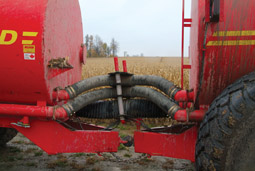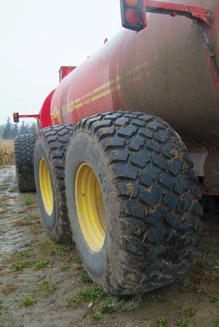
When a grower or custom applicator is hauling 10,000 to 12,000 gallons
of manure down a public highway, everything on that trailer has to work
flawlessly.
It is hard not to notice the scale of today’s top-flight manure spreaders, and there is a considerable degree of engineering required on every element of the equipment, from the shapes of the tanks to the tires they ride on. When a grower or custom applicator is hauling 10,000 to 12,000 gallons of manure down a public highway, everything on that trailer has to work flawlessly.
 |
| Dennis Nuhn, president of Nuhn Industries in Sebringville, Ontario, says farmers are taking manure farther and farther, making load, speed and ride more important. Contributed Photos. |
“Farmers are taking manure farther and farther,” says Dennis Nuhn, president of Nuhn Industries in Sebringville, Ontario. “Load is important. Speed is important. Ride is important.” Not only are they important, they are more challenging than ever as equipment has bulked up in recent years. In fact, Nuhn points out that his latest Quad Train liquid manure spreader carries more than twice the capacity of his first big tank, which he introduced nearly two decades ago. To deliver that performance – over more road miles, and at higher speeds, than ever – the company relies on design.
Rather than designing a complicated frame to manage a high center of gravity, Nuhn contoured his 0.25 inch steel tanks to keep their load low to the ground. The in-tank agitation pump has no moving parts, and does double duty by circulating material through both tanks at once for thorough agitation and even application of nutrients.
And rather than multi-axle trailers with hydraulic kingpin steering systems, the tanks are mounted on big tires and a stronger, simpler walking tandem suspension. As a result, it is not hydraulics that turn the Quad Train on a dime, it is geometry. The tongue system transfers 10,000 pounds of load to the tractor, to transfer weight and improves traction as a result. Each tank has just two axles that oscillate independently. Pivot points and axles are placed precisely on each tank, balancing the weight evenly among the tires and allowing rear wheels to follow in the tracks of the front ones.
The results include a great ride, controlled compaction and less lateral force that can twist and torture the last tire on the inside position of a multi-axle arrangement. Dragging tires through a turn is tough on roads and tough on tires. Tires are something of a secret weapon for designers of manure tanks and spreaders. The ideal tire does not just handle a big load. Big loads become staggering when full manure tanks drop into ditches or culverts; swing around corners, shifting weight to one side, then another; or when the unit is running along the side of a hill, the lower tires carry more than their fair share.
 |
| The tongue system on the Nuhn Quad Train transfers 10,000 pounds of load to the tractor, to transfer weight and improves traction as a result. |
“Off-road, severe conditions really beat a tire up,” says Nuhn. “They take a tremendous amount of abuse off-road. And when you add in inertia when the tire goes into a ditch, you could be looking at two, three, or four times the designed load.” Even running on decent roads can be tough on tires.
“Higher load and higher speed exert tremendous forces on every aspect of a tire, from strain in the bead area around the rim to heat buildup around the shoulders,” says Dr. George Ronai, head of research and development for Alliance Tire, a leader in flotation tire technology. “Tire development must take into account all of those stresses and result in a tire that performs and lasts.”
An under-engineered tire can break down under the demands of moving manure, notes Darren Dietz, territory manager for Carlisle Tire in Waterloo, Ontario. High stress causes some tires to lose air around the bead, break down in the stressed area where the bead holds onto the rim, or loss of carrying capacity as sidewalls weaken. “Some farmers can get by for a while by putting in natural rubber tubes, which flex with the radial sidewalls without scuffing inside the carcass,” Dietz says. “But that’s just a temporary fix. The tubes insulate the rim, so the metal can’t draw heat out of the tire. Eventually, the tire overheats and loses its capacity to carry the load it’s rated for.”
 |
| Don Wagner (left), a technical director, and Darren Dietz, a territory manager, both with Carlisle Tire of Waterloo, Ontario, examine the radial flotation tires mounted on a Nuhn Quad Train liquid manure tanker. |
Designers like Nuhn seek out special features that most users might not even notice – features like wear bars on the corners of the tires, which allow them to turn more easily and minimize the chance of digging grooves into the road, or rim guards, which protect the bead of the tire. When he set his sights on developing a 10,000 to 12,000 gallon tandem, Nuhn realized that the project demanded that someone design him a new tire. Instead of the 28LR26 that is typically used on big manure equipment, he wanted a 30.5LR32 tire, one with rounded corners that turn better and a more open tread to clean itself in muddy conditions. The larger size also offers a huge platform with two metric tons more capacity than the smaller tire. It also fits on standard North American rims, so he could offer buyers a choice of radial or bias-ply tires without having to change rims.
To begin building a better tire, Nuhn called Don Wagner, technical director for Carlisle, which has long supplied him with tires. Wagner called the R&D team at Alliance Tire, whose expertise in radial flotation tires has made them a market leader in high load, high performance tires around the world. Alliance’s A-390 design combines the aggressiveness and self-cleaning of lug tires with the massive footprint of turf tires. It has a steel belted 30.5LR32 that can support 1500 gallons of manure per tire and carry it down the road at 31mph (50km/h).
Nuhn has a strong preference for steel belted radials over bias-ply flotation tires. “Those big tires are your suspension,” he says, pointing out that the more flexible sidewall of a radial tire absorbs shock while spreading out the tire’s footprint to improve handling and reduce compaction. “As far as I’m concerned, you’ll get a far flatter, better distributed footprint with steel belts, plus the puncture resistance from the steel.”
 |
 |
| Each tank on the Nuhn Quad Train has just two axles that oscillate independently. Pivot points and axles are placed precisely on each tank, balancing the weight evenly among the tires and allowing rear wheels to follow in the tracks of the front ones. | After about 800 loads – about eight million gallons of manure hauled over gravel and pavement at speeds up to 31mph (50km/h) – the tires showed minimal tread wear and no evidence of bead chafing. |
An Ontario farmer agreed to put the new tires to the test under his 10,000 gallon Quad Train last year. He says he saw performance differences right away. “I’m seeing them sitting down flatter,” reports the grower. “They’re not twisting and bucking like the other tires used on the unit, so the turning is better. With our other tires, we were buying new pavement every year – when the pavement got hot in July or August, those other tires just chewed it up. And they stay clean – we’re not stopping to clean up mud on the road. We’re going to get by better with the township with these tires.”
After about 800 loads – about eight million gallons of manure, often hauled at up to six kilometers (four miles) at 50km/h (3 mph) over gravel and pavement – Wagner’s team at Carlisle dismounted the tires and pored over them with a fine-tooth comb. “The tire showed very minimal amount of tread wear, we estimated under 10 percent,” Wagner reports. “The tire also showed no evidence of bead chafing, proving to us that Alliance engineers have done their homework during the development of this tire. We consider this tire a ‘home run’,” Wagner adds. “We are very impressed with the tire and its importance.”
When 10,000 or 12,000 gallons of manure heads down the road in a hurry, keeping busy producers productive, it is good to know that the load is on a strong foundation. -end-
Print this page